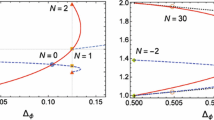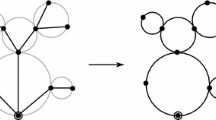Abstract
We study rooted self avoiding polygons and self avoiding walks on deterministic fractal lattices of finite ramification index. Different sites on such lattices are not equivalent, and the number of rooted open walks W n (S), and rooted self-avoiding polygons P n (S) of n steps depend on the root S. We use exact recursion equations on the fractal to determine the generating functions for P n (S), and W n(S) for an arbitrary point S on the lattice. These are used to compute the averages \(\langle P_{n}(S) \rangle\),\(\langle W_{n}(S) \rangle\),\(\langle \log P_{n}(S) \rangle\) and \(\langle \log W_{n}(S) \rangle\) over different positions of S. We find that the connectivity constant μ, and the radius of gyration exponent \(\nu\) are the same for the annealed and quenched averages. However, \(\langle \log P_{n}(S) \rangle \simeq n \log \mu + (\alpha_q - 2)\log n\), and \(\langle \log W_{n}(S) \rangle \simeq n \log \mu + (\gamma_q-1) log{n}\), where the exponents \(\alpha_q\) and \(\gamma_q\), take values different from the annealed case. These are expressed as the Lyapunov exponents of random product of finite-dimensional matrices. For the 3-simplex lattice, our numerical estimation gives \(\alpha_q \simeq 0.72837 \pm 0.00001;\) and \(\gamma_q \simeq 1.37501 \pm 0.00003\), to be compared with the known annealed values \(\alpha_a = 0.73421\) and \(\gamma_q = 1.37522\).
Similar content being viewed by others
References
K. Barat and B. K. Chakrabarti, Statistics of self-avoiding walk on random lattices. Phys. Rep. 258:377 (1995).
B. K. Charabarti (ed.), Statistics of Linear Polymers in Disordered Media (Elsevier, Amsterdam, 2005).
D. Dhar, Self-avoiding random walks:some exactly soluble cases, J. Math. Phys. 19:5–11 (1978).
R. Rammal, G. Toulose and J. Vannimenus, J. Phys. (Paris) 45:389 (1984).
D. Dhar and Y. Singh, in Statistics of linear polymers in disordered media, B. K. Charabarti (ed.) (Elsevier, Amsterdam, 2005), p. 149. [cond-mat/0508330]
Mathematica Wolfram Research http://www.wolfram.com/
F. D. A. Reis, Diffusion on regular random fractals, J. Phys. A: Math. Gen. 29:7803–7810 (1996).
A. Ordemann, M. Porto and H. E. Roman, Self-avoiding walks on Sierpinski lattices in two and three dimensions, Phys. Rev. E 65:021107 (2002).
For a mathematical derivation of the log-periodic oscillations in of the Taylor coefficients of functions satisfying functional equations similar to Eq. (28). see A. M. Odlyzko, Adv. Math. 44:180 (1982). See also, G. Paul, Phys. Rev. E59:4847 (1999); P. J. Grabner and W. Woess, Stochastic Processes and their Applications 69:127–138 (1997); B. Kron and E. Teufl, Transactions of the American Mathematical Society 356:393–414 (2003).
S. Gluzman and D. Sornette, Log-periodic route to fractal functions, Phys. Rev. E65:036142 (2002); D. Sornette, Discrete scale invariance and complex dimensions, Phys. Rep. 297:239–270 (1998).
A. Crisanti, G. Paladin and A. Vulpiani, Products of Random Matrices in Statistical Physics, Springer Series in Solid State Science, Vol. 104 (Springer, Berlin, 1993).
A. Mukherjee, Topics in Products of Random Matrices (Narosa, New Delhi, 2000).
H. Furstenberg and H. Kesten, Ann. Math. Stat. 31:457 (1960).
T. Halpin-Healy and Y. -C. Zhang, Kinetic roughening, stochastic growth, directed polymers and all that, Phys. Rep. 254:215 (1995).
A. V. Izyumov and K. V. Samokhin, Field theory of self-avoiding walks in random media, J. Phys. A 32:7843 (1999).
A. B. Harris, Phys. Rev. Lett. 63:2819 (1989).
S. B. Lee and H. Nakanishi, Monte Carlo study of self-avoiding walks on a critical percolation cluster, Phys. Rev. B 39:9561 (1989); Self-avoiding walks on randomly diluted lattices, Phys. Rev. Lett. 61:2022 (1988).
Y. Y. Goldschmidt and Y. Shiferaw, Localization of Polymers in Random Media: Analogy with Quantum Particles in Disorder, book chapter in “Statistics of Linear Polymers in Disordered Media,” edited by B.K. Chakrabarti, Elsevier 2005; also see other chapters in the book.
Author information
Authors and Affiliations
Rights and permissions
About this article
Cite this article
Sumedha, Dhar, D. Quenched Averages for Self-Avoiding Walks and Polygons on Deterministic Fractals. J Stat Phys 125, 55–76 (2006). https://doi.org/10.1007/s10955-006-9098-7
Received:
Accepted:
Published:
Issue Date:
DOI: https://doi.org/10.1007/s10955-006-9098-7




